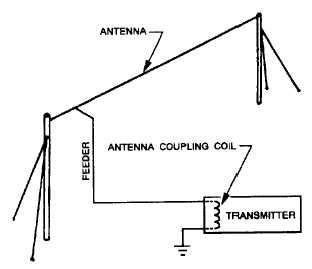4-3
The conventional antenna is a conductor, or system of conductors, that radiates or intercepts
electromagnetic wave energy. An ideal antenna has a definite length and a uniform diameter, and is
completely isolated in space. However, this ideal antenna is not realistic. Many factors make the design of
an antenna for a communications system a more complex problem than you would expect. These factors
include the height of the radiator above the earth, the conductivity of the earth below it, and the shape and
dimensions of the antenna. All of these factors affect the radiated-field pattern of the antenna in space.
Another problem in antenna design is that the radiation pattern of the antenna must be directed between
certain angles in a horizontal or vertical plane, or both.
Most practical transmitting antennas are divided into two basic classifications, HERTZ (half-wave)
ANTENNAS and MARCONI (quarter-wave) ANTENNAS. Hertz antennas are generally installed some
distance above the ground and are positioned to radiate either vertically or horizontally. Marconi antennas
operate with one end grounded and are mounted perpendicular to the Earth or to a surface acting as a
ground. Hertz antennas are generally used for frequencies above 2 megahertz. Marconi antennas are used
for frequencies below 2 megahertz and may be used at higher frequencies in certain applications.
A complete antenna system consists of three parts: (1) The COUPLING DEVICE, (2) the FEEDER,
and (3) the ANTENNA, as shown in figure 4-2. The coupling device (coupling coil) connects the
transmitter to the feeder. The feeder is a transmission line that carries energy to the antenna. The antenna
radiates this energy into space.
Figure 4-2.—Typical antenna system.
The factors that determine the type, size, and shape of the antenna are (1) the frequency of operation
of the transmitter, (2) the amount of power to be radiated, and (3) the general direction of the receiving
set. Typical antennas are shown in figure 4-3.

